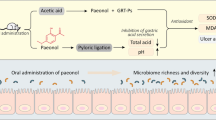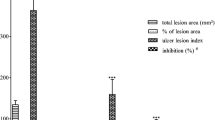Abstract
Studies were conducted in pylorus-ligated rats to investigate the effect of Cannabis sativa extract on gastric acid secretion, experimental gastric ulcer and on oxidative stress and inflammatory markers in the gastric mucosa. C. sativa (5, 10 and 20 mg/kg, expressed as Δ9-tetrahydrocannabinol) was administered subcutaneously daily for 4 weeks prior to pylorus ligation and different treatments. Under basal conditions, pretreatment with cannabis extract at doses of 5 and 10 mg/kg increased gastric acid secretion and induced minimally visible gastric mucosal lesions in the 4 h pylorus-ligated rat. Malondialdehyde and nitric acid concentration increased, while reduced glutathione decreased by cannabis at doses of 5 and 10 mg/kg in gastric mucosa. TNF-α increased by cannabis extract at doses of 5 and 10 mg/kg but decreased following the high dose of 20 mg/kg. On the other hand, the gastric acid secretory responses stimulated by pentagastrin or carbachol (but not histamine) were inhibited in rats pretreated with cannabis extract. Under these conditions, cannabis decreased pepsin content after pentagastrin and carbachol but not histamine stimulation. Cannabis also decreased lipid peroxidation and nitric oxide content, and increased both reduced glutathione and catalase activity in mucosa. Moreover, cannabis decreased mucosal inflammation (level of TNF-α) and the development of gastric mucosal lesions. Cannabis administered for 1 month prior to pylorus-ligation and either acidified aspirin or ethanol (96 %) decreased the development of gastric mucosal damage in a dose-dependent manner, along with reduction in gastric acid output, gastric mucosal oxidative stress and inflammation (TNF-α). Sections of gastric mucosa stained with periodic acid Schiff showed increased mucus secretion by cannabis in basal conditions and after treatment with aspirin or ethanol. Results indicate that: (1) the effect of cannabis differs in basal conditions and after exposure of the gastric mucosa to high acid concentrations or other chemical noxious agents; (2) cannabis administered systemically exerts gastric mucosal protective effects against mucosal damage evoked by stimulation of gastric acid secretion, acidified aspirin or ethanol. These effects of cannabis are likely to involve inhibition of gastric acid and pepsin secretion, increased mucus, decreased oxidative stress and inflammation in gastric mucosa.



















Similar content being viewed by others
References
Adami M, Frati P, Bertini S, Kulkarni-Narla A, Brown DR, de Caro G, Coruzzi G, Soldani G (2002) Gastric antisecretory role and immunohistochemical localization of cannabinoid receptors in the rat stomach. Br J Pharmacol 135:1598–1606
Adami M, Zamfirova R, Sotirov E, Tashev R, Dobrinova Y, Todorov S, Coruzzi G (2004) Gastric antisecretory effects of synthetic cannabinoids after central or peripheral administration in the rat. Brain Res Bull 64:357–361
Aebi H (1984) Catalase in vitro. Methods Enzymol 108:121–126
Agus SS (2005) Gastroprotective effect of curcumine on ethanol-induced gastric mucosal lesions in rats. Folia Med Indones 41:85–89
Aihara T, Nakamura E, Amagase K, Tomita K, Fujishita T, Furutani K, Okabe S (2003) Pharmacological control of gastric acid secretion for the treatment of acid-related peptic disease: past, present, and future. Pharmacol Ther 98:109–127
Aivado M, Spentzos D, Germing U, Alterovitz G, Meng XY, Grall F, Giagounidis AAN, Klement G, Steidl U, Otu HH, Czibere A et al (2007) Serum proteome profiling detects myelodysplastic syndromes and identifies CXC chemokine ligands 4 and 7 as markers for advanced disease. Science 104:1307–1312
Allen A, Flemström G (2005) Gastroduodenal mucus bicarbonate barrier: protection against acid and pepsin. Am J Physiol Cell Physiol 288:1–19
Allen A, Pearson JP, Blackburn A, Coan RM, Hutton DA, Mall AS (1988) Pepsins and the mucus barrier in peptic ulcer disease. Scand J Gastroenterol 23:50–57
Allen A, Flemstrom G, Garner A, Kivilaakso E (1993) Gastroduodenal mucosal protection. Physiol Rev 73:823–857
Ashton CH (2001) Pharmacology and effects of cannabis: a brief review. Br J Psychiatry 178:101–106
Banerjee R (1990) Non-steroidal anti-inflammatory drugs inhibit gastric peroxides activity. Biochim Biophys Acta 1034:275–280
Beutler E, Duron O, Kelly BM (1963) Improved method for the determination of blood glutathione. J Lab Clin Med 61:882–888
Brenneisen R (2006) Chemistry and analysis of phytocannabinoids and other cannabis constituents. In: ElSohly MA (ed) Forensic science and medicine: marijuana and the cannabinoids. Humana, Totowa, pp 17–49
Calatayud S, Barrachina D, Espluges JV (2001) Nitric oxide:relation to integrity, injury, and healing of the gastric mucosa. Microsc Res Tech 53:325–335
Coruzzi G, Adami M, Coppelli G, Frati P, Soldani G (1999) Inhibitory effect of the cannabinoid receptor agonist WIN 55,212-2 on pentagastrin-induced gastric acid secretion in the anaesthetized rat. Naunyn Schmiedebergs Arch Pharmacol 360:715–8
Coruzzi G, Adami M, Guaita E, Menozzi A, Bertini S, Giovannini E, Soldani G (2006) Effects of cannabinoid receptor agonists on rat gastric acid secretion: discrepancy between in vitro and in vivo data. Dig Dis Sci 51:310–317
Cosku O, Kanter M, Armutcu F, Cetin K, Katbalmaz B, Yazgan O (2004) Protective effect of quercetin and flavonoid antioxidant, in absolute induced gastric ulcer. Eur J Gen Med 1:37–42
Davenport HW (1964) Gastric mucosal injury by fatty and acetylsalicylic acids. Gastroenterology 46:245–253
Dembiński A, Warzecha Z, Ceranowicz P, Dembiński M, Cieszkowski J, Pawlik W, Konturek SJ, Tomaszewska R, Hładki W, Konturek PC (2006) Cannabinoids in acute gastric damage and pancreatitis. J Physiol Pharmacol 57:137–154
Devane WA, Dysarz FA, Johnson MR, Melvin LS, Howlett AC (1988) Determination and characterization of a cannabinoid receptor in rat brain. Mol Pharmacol 34:605–613
Ehrlich K, Sicking C, Respondek M, Peskar BM (2004) Interaction of cyclooxygenase isoenzymes, nitric oxide, and afferent neurons in gastric mucosal defense in rats. J Pharmacol Exp Ther 308:277–283
Elsohly MA, Slade D (2005) Chemical constituents of marijuana: the complex mixture of natural cannabinoids. Life Sci 78:539–548
Farinati F, Della Libera G, Cardin R, Molari A, Plebani M, Rugge M, Di Mario F, Naccarato R (1996) Gastric antioxidant, nitrites, and mucosal lipoperoxidation in chronic gastritis and Helicobacter pylori infection. J Clin Gastroenterol 22:275–281
Gabriel GC, Mauricio HP, Eliana SV, Zurita E, Palacios M, Gutiérrez O (2006) Study of the gastric acid anti-secretory activity of Cannabis sativa in an animal model. Colomb Méd 37:4
Germanò MP, D'Angelo V, Mondello MR, Pergolizzi S, Capasso F, Capasso R, Izzo AA, Mascolo N, De Pasquale R (2001) Cannabinoid CB1-mediated inhibition of stress-induced gastric ulcers in rats. Naunyn Schmiedeberg’s Arch Pharmacol 363:241–244
Glavin GB, Szabo S (1993) Effects of the cachelators EGTA and EDTA on ethanol- or stress-induced gastric mucosal lesions and gastric secretion. Eur J Pharmacol 233:269–273
Gyires K (2005) Gastric mucosal protection: from prostaglandins to gene-therapy. Curr Med Chem 12:203–215
Halliwell B (2006) Reactive species and antioxidants. Redox biology is a fundamental theme of aerobic life. Plant Physiol 141:312–322
Holzer P (2000) Gastroduodenal mucosal defense. Curr Opin Gastroenterol 16:469–478
Hoppenkamps R, Thies E, Younes M, Siegers CP (1984) Glutathione and GSH-dependent enzymes in the human gastric mucosa. Klin Wochenschr 62:183–6
Howlett AC, Barth F, Bonner TI, Cabral G, Casellas P, Devane WA, Felder CC, Herkenham M, Mackie K, Martin BR, Mechoulam R, Pertwee RG (2002) Classification of cannabinoid receptors. XXVII international union of pharmacology. Pharmacol Rev 54:161–202
Huestis MA (2002) Cannabis (marijuana)—effects on human behavior and performance. Forensic Sci Rev 14:15
Iversen L (2007) The science of marijuana. Oxford University Press, Oxford
Izzo AA, Coutts AA (2005) Cannabinoids and the digestive tract. Handb Exp Pharmacol 168:573–598
Kinsey SG, Nomura DK, O’Neal ST, Long JZ, Mahadeva A, Cravatt BF, Grider JR, Lichtman AH (2011) Inhibition of monoacylglycerol lipase attenuates nonsteroidal anti-inflammatory drug-induced gastric hemorrhages in mice. J Pharmacol Exp Ther 338:795–802
Konturek PC, Kania J, Hahn EG, Konturek JW (2006) Ascorbic acid attenuates aspirin-induced gastric damage: role of inducible nitric oxide synthase. J Physiol Pharmacol 57:125–136
Lichtenberger LM (1999) Gastroduodenal mucosal defense. Curr Opin Gastroenterol 15:463–472
Miranda KM, Espey ME, Wink DA (2001) A rapid, simple spectrophotometric method for simultaneous detection of nitrate and nitrite. Biol Chem 5:62–71
Moncada S, Palmer RM, Higgs EA (1991) Nitric oxide: physiology, pathophysiology, and pharmacology. Pharmacol Rev 43:109–142
Mózsik G, Móron F, Jávor T (1982) Cellular mechanisms of the development of gastric mucosal damage and of gastrocytoprotection induced by prostacyclin in rats. A pharmacological study. Prostaglandins Leukot Med 9:71–84
Muscara MN, Wallace JL (1999) Nitric oxide: therapeutic potential of nitric oxide donors and inhibitors. Am J Physiol 276:1313–1316
Nalin DR, Levine MM, Rhead J, Bergquist E, Rennels M, Hughes T, O'Donnel S, Hornick RB (1978) Cannabis, hypochlorhydria, and cholera. Lancet 21(2):859–862
Pacher P, Bátkai S, Kunos G (2006) The endocannabinoid system as an emerging target of pharmacotherapy. Pharmacol Rev 58:389–462
Pacher P, Beckman JS, Liaudet L (2007) Nitric oxide and peroxynitrite in health and disease. Physiol Rev 87:315–424
Pertwee RG (1997) Pharmacology of cannabinoid CB1 and CB2 receptors. Pharmacol Ther 74:129–180
Pertwee RG (2005) Pharmacological actions of cannabinoids. Handb Exp Pharmacol 168:1–51
Pertwee RG, Ross RA (2002) Cannabinoid receptors and their ligands. Prostaglandins Leukot Essent Fat Acids 66:101–121
Rivas VJF, Garcûa R (1980) Inhibition of histamine-stimulated gastric acid secretion by ∆9–tetrahydrocannabinol in rat isolated stomach. Eur J Pharmacol 65:317–318
Sayre LM, Perry G, Smith MA (2008) Oxidative stress and neurotoxicity. Chem Res Toxicol 21:172–188
Shay H, Sun DCH, Gruenstein M (1954) A quantitative method for measuring spontaneous gastric secretion in the rat. Gastroenterology 26:906–913
Shujaa N, Zadori ZS, Ronai AZ, Barna I, Mergl Z, Mozes MM, Gyires K (2009) Analysis of the effect of neuropeptides and cannabinoids in gastric mucosal defense initiated centrally in the rat. J Physiol Pharmacol 60:93–100
Sies H (1991) Oxidative stress: introduction. In: Sies H (ed) Oxidative stress: oxidants and antioxidants. Academic, London
Sofia RD, Diamantis W, Harrison JE, Melton J (1978) Evaluation of antiulcer activity of ∆9-tetrahydrocannabinol in the Shay rat test. Pharmacology 17:173–177
Townsend DM, Tew KD, Tapiero H (2003) The importance of glutathione in human disease. Biomed Pharmacother 57:144–155
Tulassay Z, Herszényi L (2010) Gastric mucosal defense and cytoprotection. Best Pract Res Clin Gastroenterol 24:99–108
Turner JC, Mahlberg PG (1984) Separation of acid and neutral cannabinoids in Cannabis sativa L. using HPLC. In: Agurell S, Dewey WL, Willete RE (eds) Chemical, pharmacological and therapeutic agents. Academic, London, pp 79–88
Uchiyama M, Mihara M (1978) Determination of malondialdehyde precursor in tissues by thiobarbituric acid test. Anal Biochem 86:271–278
Wallace JL, Miller MJ (2000) Nitric oxide in mucosal defense: a little goes a long way. Gastroenterology 119:512–520
Wallace JL, Reuter BK, Cirino G (1994) Nitric oxide-releasing non-steroidal anti-inflammatory drugs: a novel approach for reducing gastrointestinal toxicity. J Gastroenterol Hepatol 9 Suppl 1:S40–4
Wallace JL, Flannigan KL, McKnight W, Wang L, Ferraz JG, Tuitt D (2013) Pro-resolution, protective and anti-nociceptive effects of a cannabis extract in the rat gastrointestinal tract. J Physiol Pharmacol 64:167–75
Warzecha Z, Dembinski A, Ceranowicz P, Dembinski M, Cieszkowski J, Kownacki P, Konturek PC (2011) Role of sensory nerves in gastroprotective effect of anandamide in rats. J Physiol Pharmacol 62:207–217
Wastell C, Colin JF, MacNatighton JI, Gleeson J (1972) Selective proximal vagotomy with and without pyloroplasty. Br Med J 1:28–30
Whittle BJR (1993) Neuronal and endothelium-derived mediators in the modulation of the gastric microcirculation: integrity in the balance. Br J Pharmacol 110:3–17
Author information
Authors and Affiliations
Corresponding author
Rights and permissions
About this article
Cite this article
Abdel-Salam, O.M.E., Salama, R.A.A., El-Denshary, EE. et al. Effect of Cannabis sativa extract on gastric acid secretion, oxidative stress and gastric mucosal integrity in rats. Comp Clin Pathol 24, 1417–1434 (2015). https://doi.org/10.1007/s00580-015-2090-3
Received:
Accepted:
Published:
Issue Date:
DOI: https://doi.org/10.1007/s00580-015-2090-3




